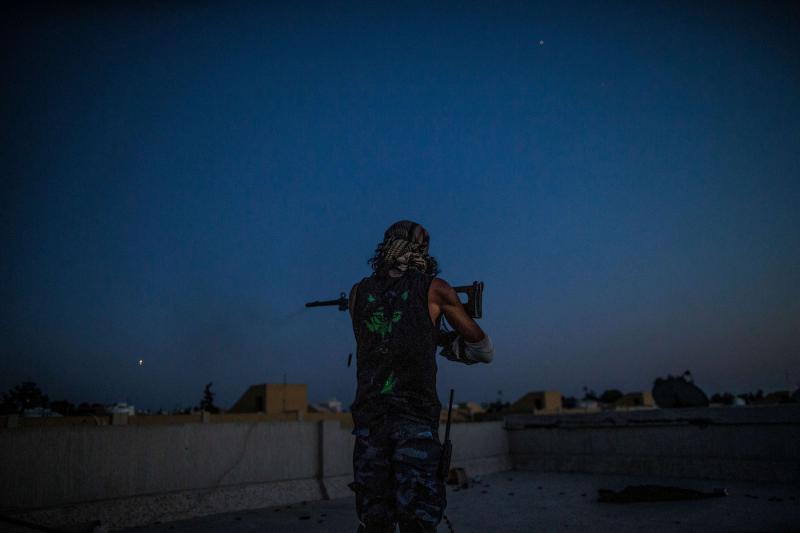Fierce fighting resumes around Tripoli as ceasefire ends
TUNIS - Intense fighting broke out in Libya after the brief Eid al-Adha ceasefire, with rival forces bombarding Tripoli and the southern town of Murzuq with air strikes, anti-aircraft and anti-tank weapons.
Clashes between the Libyan National Army (LNA) and Islamist militias aligned with the UN-backed government of Tripoli killed at least 90 people August 20 in Tripoli, the United Nations said, and renewed concerns about civilian casualties.
The UN Office for the Coordination of Humanitarian Affairs (UNOCHA) said in a statement that 90 people were killed the same day in Murzuq. At least two children were killed and four wounded in the fighting, it added.
"Casualties on all sides of the fighting have continued as a result of air strikes by planes and drones, indiscriminate rocket attacks and shelling and direct fighting on the ground in Murzuq," said UNOCHA.
LNA spokesman Colonel Ahmed al-Mismari blamed "criminal gangs" and Islamist militias linked to the UN-backed Government of National Accord (GNA) for driving civilians out of Murzuq by force.
"Today (August 21), Murzuq has turned into a ghost town,” Mismari said in a statement. “Its population was forced to leave to Traguen, Sebha and Wadi Ataba. Thousands of families were driven out of their homes. Houses, shops and public buildings were set ablaze. The fires are still raging.”
Libyan analysts said the fighting in Murzuq was linked to the intensifying battle in Tripoli. They said it was part of Islamist militias’ strategy to stretch LNA forces and aircraft as they deploy air strikes to a wider area around Tripoli.
Mismari said: "The LNA's air operations are continuing and our forces are ready for more action in Murzuq as the situation there needs.”
At Esbeia, on the outskirts of Tripoli, at least 20 soldiers were killed in two days of fighting, statements from both sides said.
LNA soldiers had withdrawn from Esbeia and the GNA claimed to have taken the area. However, the LNA said it struck at militiamen before they became entrenched in the town, "killing and wounding many of the gunmen.”
The cat-and-mouse strategy is aimed at weakening the Tripoli militias before the LNA enters the centre of Tripoli, to avoid civilian casualties and damaging infrastructure.
Esbeia controls the main road linking Tarhouna, the LNA’s main base south of Tripoli, and Quasar Bin Ghishir on the outskirts of the capital.
Libya media reported heavy air fire in at least three areas south of Tripoli, including Laziziya and Ain Zara, as clashes continued early August 22.
"LNA troops lured terrorist gangs outside Laziziya to kill and destroy them,” said Mismari. “LNA jet fighters struck the gangs and destroyed at least ten military trucks. LNA land troops moved in to chase the terrorists towards Laziziya.”
The LNA, led by Field-Marshal Khalifa Haftar, began an offensive April 4 to take control of Tripoli, which it claims is controlled by Islamic militants backed by the Muslim Brotherhood.
The LNA has advanced nearly 20km into southern Tripoli since then and the front lines are about 5km from Tripoli centre. However, there has been little movement in the past month despite intensified air strikes, including in Misrata, the Islamists’ main stronghold.
LNA commanders warned they will continue with air strikes against Misrata’s airbase and seaport until the militias stop fighting in Tripoli.
Analysts say the outcome of the conflict in Tripoli will not only shape the future of Libyan politics but affect security across the Maghreb.
LNA forces seized Murzuq early this year as part of an offensive to control the oil-producing south, before concentrating its forces to the north. The situation in Murzuq and other southern areas is fragile because of entrenched rivalries over access to oil and mineral resources and control of roads.
Lamine Ghanmi is a veteran Reuters journalist. He has covered North Africa for decades and is based in Tunis.
This article was originally published in The Arab Weekly.




